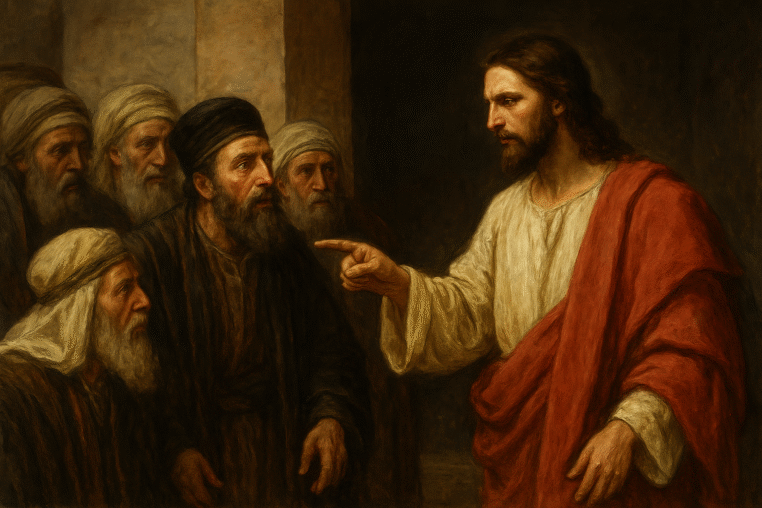In order to understand Jesus you have to learn what happened before his birth.
The Gospel of Matthew, chapter 23, contains one of the most intense and direct confrontations in the New Testament: Jesus’ series of “woes” directed at the scribes and Pharisees. These religious leaders, prominent in 1st-century Judaism, are repeatedly called “hypocrites” by Jesus, a term that implies not just inconsistency but active deceit—pretending to be pious while engaging in self-serving behaviors that distorted God’s truth. In the historical context, the Pharisees were a lay sect that emphasized strict adherence to the Torah and oral traditions, emerging after the Maccabean Revolt (c. 167–160 BCE) to preserve Jewish identity amid Hellenistic and Roman influences. Josephus, a 1st-century Jewish historian, describes them as a respected group with significant influence over the people, known for their precise interpretations of the law and belief in resurrection (Antiquities 18.1.3). However, Jesus portrayed their practices as a form of lying: outwardly religious but inwardly corrupt, nullifying God’s commands for human gain.
This article examines Jesus’ woes in Matthew 23, breaking down what he said, why he said it (rooted in the socio-religious tensions of the time), and historical evidence supporting the view that the Pharisees engaged in deceitful manipulation. Drawing from Gospel texts, Josephus’ accounts, and scholarly analyses, we see how their oral traditions and public displays often prioritized status over genuine faith, leading Jesus to condemn them as barriers to the kingdom of God. This critique wasn’t anti-Jewish—Jesus himself was Jewish—but an intra-Jewish call for reform against institutionalized hypocrisy.
The Foundation of Jesus’ Rebuke: External Piety vs. Internal Truth
Jesus begins his discourse by acknowledging the Pharisees’ authority: “The teachers of the law and the Pharisees sit in Moses’ seat. So you must be careful to do everything they tell you. But do not do what they do, for they do not practice what they preach” (Matthew 23:2-3, NIV). Here, Jesus highlights a core deceit: they taught the law but failed to live it, creating a double standard. Historically, the Pharisees developed oral laws to “fence” the Torah, preventing accidental violations—such as elaborate Sabbath rules not found in scripture. Josephus notes their commitment to these “traditions of the fathers” (Antiquities 13.10.6), which gave them influence but also led to accusations of burdening the common people (am ha’aretz), who couldn’t afford or understand the complexities.
Why did Jesus say this? In a time of Roman occupation, Pharisees positioned themselves as guardians of Jewish purity, but Jesus saw their rules as deceptive additions that obscured God’s mercy. Quote 1: “They tie up heavy, cumbersome loads and put them on other people’s shoulders, but they themselves are not willing to lift a finger to move them” (Matthew 23:4). This refers to the expansion of Mosaic law into hundreds of regulations, like tithing spices (Matthew 23:23) while neglecting justice. Scholar E.P. Sanders’ concept of “covenantal nomism” explains Pharisaic theology as grace-based entry into the covenant followed by law-keeping for maintenance, but Jesus argued it devolved into legalism that deceived people about God’s priorities (Paul and Palestinian Judaism, 1977). Historical evidence from the Dead Sea Scrolls (e.g., Damascus Document) shows similar sectarian rules among Essenes, but Pharisees’ application in synagogues made it widespread deceit, per Amy-Jill Levine’s analysis of intra-Jewish debates (The Misunderstood Jew, 2006).
Quote 2: “Everything they do is done for people to see: They make their phylacteries wide and the tassels on their garments long” (Matthew 23:5). Phylacteries (tefillin) and tassels (tzitzit) were biblical (Deuteronomy 6:8, Numbers 15:38), but enlarging them for visibility was a show of piety. Archaeological finds from Qumran confirm ornate religious items in 1st-century Judaism, but Jesus called it lying—faking devotion for honor. Josephus praises their public respect (Wars 2.8.14), but this fueled hypocrisy, as they sought titles like “Rabbi” (Matthew 23:7-10), deceiving followers into idolizing leaders over God.
The Seven Woes: Specific Accusations of Deceit and Lying
The “seven woes” (Matthew 23:13-36) escalate the critique, each starting with “Woe to you, teachers of the law and Pharisees, you hypocrites!”—a prophetic lament echoing Isaiah 5’s woes on Israel. Jesus accuses them of active deceit, blocking spiritual access while pretending to guide.
Quote 3: “Woe to you… you hypocrites! You shut the door of the kingdom of heaven in people’s faces. You yourselves do not enter, nor will you let those enter who are trying to” (Matthew 23:13). Why? Pharisees’ exclusive interpretations (e.g., strict Sabbath observance) barred “sinners” like tax collectors. Historically, Josephus notes their control over rituals (Antiquities 18.1.3), but Jesus saw this as lying—promising the kingdom but withholding it through rules. Levine argues this was rhetorical exaggeration in Jewish debate, but evidence from Mishnah (Sanhedrin 10:1) shows Pharisees debating salvation, often excluding outsiders.
Quote 4: “Woe to you… you hypocrites! You travel over land and sea to win a single convert, and when you have succeeded, you make them twice as much a child of hell as you are” (Matthew 23:15). Pharisees proselytized Gentiles (Josephus, Wars 2.17.10), but Jesus said they deceived converts into legalism over love. Sanders notes covenantal nomism included proselytes via circumcision and law, but Jesus critiqued it as hell-bound deceit (covenantal nomism didn’t emphasize “hell” as Pharisees did resurrection, but Jesus used it hyperbolically).
Quote 5: “Woe to you, blind guides! You say, ‘If anyone swears by the temple, it means nothing; but anyone who swears by the gold of the temple is bound by that oath’” (Matthew 23:16). This woe exposes casuistry—twisting oaths to lie without consequence. Mishnah Nedarim details similar vow loopholes, historical evidence of Pharisaic legal maneuvering to avoid obligations.
Quote 6: “Woe to you… you hypocrites! You give a tenth of your spices—mint, dill and cumin. But you have neglected the more important matters of the law—justice, mercy and faithfulness” (Matthew 23:23). Tithing was biblical (Leviticus 27:30), but extending to herbs was oral tradition. Jesus called neglecting weightier matters (Micah 6:8) a lie of priorities. Josephus confirms their tithing zeal (Antiquities 14.9.4), but Sanders sees it as covenant maintenance, not deceit—yet Jesus framed it as hypocritical omission.
Quote 7: “Woe to you… you hypocrites! You clean the outside of the cup and dish, but inside they are full of greed and self-indulgence” (Matthew 23:25). Ritual purity (Mark 7) was Pharisaic hallmark, but Jesus said inner greed made it deceitful. Levine notes this echoes Jewish prophets like Amos, but in Roman context, it critiqued economic exploitation (e.g., temple taxes).
Quote 8: “Woe to you… you hypocrites! You are like whitewashed tombs, which look beautiful on the outside but on the inside are full of the bones of the dead and everything unclean” (Matthew 23:27). Tombs were whitewashed for purity (Numbers 19), but Jesus used it to symbolize hidden impurity. Historical parallel: Josephus on Essene purity (Wars 2.8.7), but Pharisees’ public image masked flaws.
Quote 9: “Woe to you… you hypocrites! You build tombs for the prophets and decorate the graves of the righteous” (Matthew 23:29). They honored past prophets while killing current ones (like Jesus). Evidence: 1st-century prophet tombs exist archaeologically, and Josephus records Pharisee involvement in executions (Antiquities 17.2.4).
Quote 10: “You snakes! You brood of vipers! How will you escape being condemned to hell?” (Matthew 23:33). Culminating in judgment, echoing John the Baptist (Matthew 3:7). Why? Their deceit led to spiritual death. Sanders argues Pharisaic theology was grace-based, but Jesus saw it as lying through actions.
Historical Evidence: Confirming the Deceit
Beyond Gospels, Josephus portrays Pharisees positively but notes their political plotting (e.g., against Herod, Wars 1.29.2), supporting deceit for influence. Levine emphasizes that Jesus’ criticisms were typical Jewish prophetic rhetoric, not anti-Semitism, but historical tensions (e.g., post-70 CE rabbinic reforms) show Pharisee successors adapted, implying earlier flaws. Sanders’ covenantal nomism reframes them as not legalistic, but Gospel evidence of corban vows (Mark 7:11) shows real deceit in evading duties.
Jesus’ woes unmask Pharisaic hypocrisy as religious deceit, deceiving people about God’s heart. Historical sources confirm their influence but validate Jesus’ call for inner truth over external show.
References
- Historical Narratives and the Pharisees – Times & Seasons (web:0)
- The “Hypocrisy” of the Pharisees | Jerusalem Perspective (web:1)
- Woes of the Pharisees – Wikipedia (web:2)
- Beware the Yeast of the Pharisees | The Banner (web:3)
- Unveiling the True Burden of Hypocrisy About the Pharisees (web:4)
- Why Were the Pharisees the ‘Bad Guys’ in the Bible? | HowStuffWorks (web:5)
- Who Were the Pharisees? Jesus Criticized the … – Jacki Kellum (web:6)
- How Close Were Jesus and the Pharisees? – From the Desk (web:7)
- Why did Jesus dislike the Pharisees? – A Pentecostal Blog & Podcast (web:8)
- Jesus and the Pharisees – 5 Attitudes Condemned – Jesus Film Project (web:9)
- Josephus on 1st Century Roman Jewish History – James Tabor Blog (web:10)
- Flavius Josephus and the Pharisees | Bible Interp (web:11)
- Josephus on the Jewish Theologies of Hell (web:12)
- a note on josephus, the pharisees and – Brill (web:13)
- Ancient Jewish Sects: Pharisees and Sadducees (web:14)
- Josephus – Wikipedia (web:15)
- Josephus | First Century Christian Faith (FCCF) (web:16)
- Pharisees Part One: Historical Reconstruction (web:17)
- Episode 13: Pharisees and Sadducees and Scribes, OH MY! (web:18)
- [PDF] The Pharisees in Judaism Prior to AD 70 – Andrews University (web:19)
- [PDF] Introduction II. To the Pharisees: Judgment Woes Pronounced, 23 … (web:20)
- The controversy dialogue leading towards Jesus’ severe response … (web:21)
- Why did Jesus rebuke the scribes and Pharisees so harshly in … (web:22)
- Matthew 23:1-39, Pharisees, and Seven Woes on False Religion (web:23)
- Woe to the Hypocrites – Matthew 23:13-36 (web:24)
- Matthew 23:13-28, Judgment upon false teachers – FCC (web:25)
- Matthew 23 Commentary – Precept Austin (web:26)
- Insides and Outsides, Matthew 23:25-28 – Bethany Bible Church (web:27)
- Enduring Word Bible Commentary Matthew Chapter 23 (web:28)
- Gospel, Matthew 23:13-22 Seven Woes to the Scribes … – Facebook (web:29)
- Dr. Amy-Jill Levine – Jesus The Misunderstood Jew – YouTube (web:30)
- Messiah Mondays – Amy-Jill Levine’s “The Misunderstood Jew” and … (web:31)
- Amy-Jill Levine: Prophet to the Church – by Scot McKnight (web:32)
- View of Amy-Jill Levine. The Misunderstood Jew (web:33)
- Full text of “The Misunderstood Jew: The Church and the Scandal of … (web:34)
- Don’t make Judaism look bad to make Jesus look good. – Outreach (web:35)
- Episode 278: Amy-Jill Levine – Who Are the Pharisees Actually? (web:36)
- Ep. 57: Meeting Jewish Jesus For the First Time w/ Dr. Amy Jill Levine (web:37)
- Were the Pharisees Bad People? – From the Desk (web:38)
- Amy-Jill Levine – Audio Books, Best Sellers, Author Bio | Audible.com (web:39)
- Gallant: Covenantial Nomism? (Review of Sanders and Carson et al) (web:40)
- Paul the Apostle and Sanders the Critic – ANCIENT JEW REVIEW (web:41)
- E.P. Sanders’ ‘common Judaism,’ Jesus, and the Pharisees … – Gale (web:42)
- RIP: Tribute to E.P. Sanders – The Busybody (web:43)
- Jesus and Judaism – The Gospel Coalition (web:44)
- Review and Reaction, E.P. Sanders, Judaism Practice and Belief (web:45)
- E. P. Sanders – Wikipedia (web:46)
- JUSTIFICATION AND VARIEGATED NOMISM – The Gospel Coalition (web:47)
- [PDF] HERMENEUTICS OF THE NEW PERSPECTIVE ON PAUL (web:48)
- The Apostle Paul and variegated nomism. – the archives near Emmaus (web:49)

